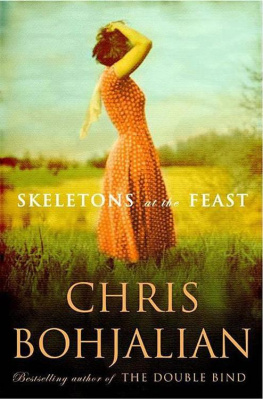Contents
COVER PAGE
TITLE PAGE
DEDICATION
EPIGRAPH
AUTHORS NOTE
PROLOGUE
CHAPTER ONE
CHAPTER TWO
CHAPTER THREE
CHAPTER FOUR
CHAPTER FIVE
CHAPTER SIX
CHAPTER SEVEN
CHAPTER EIGHT
CHAPTER NINE
CHAPTER TEN
CHAPTER ELEVEN
CHAPTER TWELVE
CHAPTER THIRTEEN
CHAPTER FOURTEEN
CHAPTER FIFTEEN
CHAPTER SIXTEEN
CHAPTER SEVENTEEN
CHAPTER EIGHTEEN
CHAPTER NINETEEN
CHAPTER TWENTY
CHAPTER TWENTY-ONE
CHAPTER TWENTY-TWO
CHAPTER TWENTY-THREE
CHAPTER TWENTY-FOUR
CHAPTER TWENTY-FIVE
CHAPTER TWENTY-SIX
CHAPTER TWENTY-SEVEN
CHAPTER TWENTY-EIGHT
CHAPTER TWENTY-NINE
ACKNOWLEDGMENTS
ABOUT THE AUTHOR
BOOKS BY CHRIS BOHJALIAN
A READERS GUIDE
A NOTE TO THE READER
QUESTIONS FOR DISCUSSION
COPYRIGHT
For Rose Mary Muench
and
in memory of Frederick Muench (1929-2004)
Oh, I know who Pauline Kael is, he said. I wasnt born homeless, you know.
NICK HORNBY, A Long Way Down
A UTHORS N OTE
T HIS NOVEL HAD ITS ORIGINS IN D ECEMBER 2003, when Rita Markley, the executive director of Burlington, Vermonts, Committee on Temporary Shelter, shared with me the contents of a box of old photographs. The black-and-white images had been taken by a once-homeless man who had died in the studio apartment her organization had found for him. His name was Bob Soupy Campbell.
The photos were remarkable, both because of the mans evident talent and because of the subject matter. I recognized the performersmusicians, comedians, actorsand newsmakers in many of them. Most of the photos were at least forty years old. We were all mystified as to how Campbell had gone from photographing luminaries from the 1950s and 1960s to winding up at a homeless shelter in northern Vermont. He had no surviving family we were aware of that we could ask.
The reality, of course, is that Campbell probably wound up homeless for any one of the myriad reasons that most transients wind up on the streets: Mental illness. Substance abuse. Bad luck.
We tend to stigmatize the homeless and blame them for their plight. We are oblivious to the fact that most had lives as serious as our own before everything fell apart. The photographs in this book are a testimony to that reality: They were taken by Campbell before he wound up a transient in Vermont.
Consequently, I am grateful to Burlingtons Committee on Temporary Shelter for allowing me to use these photographs in this story. Obviously, Bobbie Crocker, the homeless photographer in this novel, is fictitious. But the photographs you will see in this book are real.
P ROLOGUE
L AUREL E STABROOK was nearly raped the fall of her sophomore year of college. Quite likely she was nearly murdered that autumn. This was no date-rape disaster with a handsome, entitled UVM frat boy after the two of them had spent too much time flirting beside the bulbous steel of a beer keg; this was one of those violent, sinister attacks involving masked menyes, men, plural, and they actually were wearing wool ski masks that shielded all but their eyes and the snarling rifts of their mouthsthat one presumes only happens to other women in distant states. To victims whose faces appear on the morning news programs, and whose devastated, forever-wrecked mothers are interviewed by strikingly beautiful anchorwomen.
She was biking on a wooded dirt road twenty miles northeast of the college in a town with a name that was both ominous and oxymoronic: Underhill. In all fairness, the girl did not find the name Underhill menacing before she was assaulted. But she also did not return there for any reason in the years after the attack. It was somewhere around six-thirty on a Sunday evening, and this was the third Sunday in a row that she had packed her well-traveled mountain bike into the back of her roommate Talias station wagon and driven to Underhill to ride for miles and miles along the logging roads that snaked through the nearby forest. At the time, it struck her as beautiful country: a fairy-tale wood more Lewis than Grimm, the maples not yet the color of claret. It was all new growth, a third-generation tangle of maple and oak and ash, the remnants of stone walls still visible in the understory not far from the paths. It was nothing like the Long Island suburbs where she had grown up, a world of expensive homes with manicured lawns only blocks from a long neon-lit swath of fast-food restaurants, foreign car dealers, and weight-loss clinics in strip malls.
After the attack, of course, her memories of that patch of Vermont woods were transformed, just as the name of the nearby town gained a different, darker resonance. Later, when she recalled those roads and hillssome seeming too steep to bike, but bike them she didshe would think instead of the washboard ruts that had jangled her body and her overriding sense that the great canopy of leaves from the trees shielded too much of the view and made the woods too thick to be pretty. Sometimes, even many years later, when she would be trying to fight her way to sleep through the flurries of wakefulness, she would see those woods after the leaves had fallen, and visualize only the long finger grips of the skeletal birches.
By six-thirty that evening the sun had just about set and the air was growing moist and chilly. But she wasnt worried about the dark because she had parked her friends wagon in a gravel pull-off beside a paved road that was no more than three miles distant. There was a house beside the pull-off with a single window above an attached garage, a Cyclops visage in shingle and glass. She would be there in ten or fifteen minutes, and as she rode she was aware of the thick-lipped whistle of the breeze in the trees. She was wearing a pair of black bike shorts and a jersey with an image of a yellow tequila bottle that looked phosphorescent printed on the front. She didnt feel especially vulnerable. She felt, if anything, lithe and athletic and strong. She was nineteen.
Then a brown van passed her. Not a minivan, a real van. The sort of van that, when harmless, is filled with plumbing and electrical supplies, and when not harmless is packed with the deviant accoutrements of serial rapists and violent killers. Its only windows were small portholes high above the rear tires, and she had noticed as it passed that the window on the passenger side had been curtained off with black fabric. When the van stopped with a sudden squeal forty yards ahead of her, she knew enough to be scared. How could she not? She had grown up on Long Islandonce a dinosaur swampland at the edge of a towering range of mountains, now a giant sandbar in the shape of a salmonthe almost preternaturally strange petri dish that spawned Joel Rifkin (serial killer of seventeen women), Colin Ferguson (the LIRR slaughter), Cheryl Pierson (arranged to have her high school classmate murder her father), Richard Angelo (Good Samaritan Hospitals Angel of Death), Robert Golub (mutilated a thirteen-year-old neighbor), George Wilson (shot Jay Gatsby as he floated aimlessly in his swimming pool), John Esposito (imprisoned a ten-year-old girl in his dungeon), and Ronald DeFeo (slaughtered his family in Amityville).
















